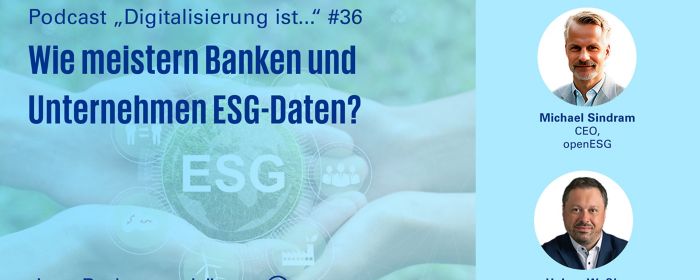Why holistic data management is crucial in the financial sector
Effective data management in the financial sector with a constantly growing amount of business data is an indispensable requirement for financial institutions today. Neglecting data governance and data management risks significant disruption to business operations. Closing gaps in data controls and data capacities is a top priority for financial institutions, especially in light of stricter regulatory requirements and increasing reporting obligations.
Our experts support you with a diverse portfolio of digital solutions to help you cope with the ever-increasing complexity of data management in financial institutions and the growing need for trustworthy data.
Our global teams with a deep understanding of sustainable change in data management will support you in the efficient transformation of your organisation. We support you in identifying and analysing areas where the strategic benefits of trusted data can lead to timely, data-driven insights into new growth and revenue opportunities.
Solutions for data governance and data-driven transformation
By applying a precise data governance model based on a risk-based approach, we help to deploy resources in a targeted manner. Your organisation can use resources more strategically and focus on driving business success. Identifying data with a significant impact on the financial situation and ensuring the highest level of trust when reporting to external parties is central to this.
Our experts support you in all tasks relating to the transformation of the data landscape. They identify strategic growth opportunities and provide valuable insights based on data-driven precision, creating confidence in critical business processes. By implementing effective data governance structures that promote collaboration, data sharing and cultural transformation, data-driven decisions are driven forward.
Our approach creates trust in data used for processes such as strategic planning, customer insights and regulatory compliance. Risks from incorrect or outdated information are minimised and companies are protected from errors and regulatory breaches - with the aim of eliminating potential sanctions.
In addition, this approach promotes cross-departmental collaboration in data management in the financial sector through data exchange and the elimination of ‘silo thinking’. This enables a modern culture of collaboration and data-driven decision-making.

We support financial institutions in the implementation of advanced AI solutions for data governance and data quality. Technologies such as machine learning, natural language processing (NLP) and generative AI improve data quality, promote well-founded decisions and minimise the risk of errors. AI solutions also open up new options on the way to a more advanced generation of data management solutions. With our digital solution portfolio, consisting of machine learning, NLP and generative AI, companies can recognise and correct errors in data sets, identify patterns and anomalies and examine unstructured data. By improving data quality with the help of AI, companies are able to make more informed decisions and reduce the risk of bias in their analyses.

Data governance is already firmly established on the corporate agenda. However, the design and implementation of effective data governance structures and the meaningful measurement of data quality are a challenge for financial institutions - and a key concern for regulators. Use our leading data governance framework for high-quality data to overcome the complex challenges in all areas of your organisation. Our agile rollout concept with user-orientated change management ensures effective implementation and a vibrant data culture. This is tailored to the individual needs of organisations in the financial sector and implements data governance and data quality standards.

ESG is of significant importance for decision-makers in financial institutions worldwide. Identifying relevant ESG data inside and outside the organisation, integrating ESG data into data aggregation processes to create meaningful ESG-related KPIs and applying ESG data to sound data management standards are the areas our experts focus on. With efficient digital solutions, they help you realise new potential.

Compliance with regulatory requirements for data management is currently a focus of the supervisory authorities. Data management capabilities are the subject of on-site inspections, stress tests and regular supervisory processes. Financial institutions must demonstrate that they have interpreted the regulatory requirements in light of their business and risk profile and have an established data management capability under the direction and effective responsibility of senior management. KPMG supports you in conducting regulatory audits and reviews. The first step is to identify and analyse potential weaknesses in compliance with the regulatory requirements relevant to data management. The focus here is on the design and implementation of compliance-relevant aspects. Then, with the help of industry benchmarks, individually tailored measures are derived for the organisation.
Client Story
Blog articles (in German only)
Further Blog articles (in German only)
- Vorbild Lebensmittel-Ampel: Datenqualität verständlicher machen
- Einen Schritt voraus: Wie KI im Kampf gegen Geldwäsche helfen kann
- Turbulente Wechselsaison: Schweres Jahr für Kfz-Versicherer
- Hey ChatGPT, welche Chancen bietet GenerativeAI der Finanzindustrie?
- Nutzen und Risiko abwägen: Interview zur KI-Verordnung der EU
- Von Datensilos zu Datenströmen
- Zentrales Datenmanagement: Weg mit den Silos!
- Wie digital arbeitet die Versicherungsbranche
- Sind durch Algorithmen getroffene Entscheidungen automatisch fair?
- KI in der Finanzwirtschaft: Die digitale Zukunft hat begonnen
- Die digitale Plattform - Das modulare und datengetriebene Fundament für die Wertschöpfungskette der Zukunft
- Data Dictionary: Klare Sicht im Datennebel - Schlechtes Datenmanagement mindert Effizienz von Reporting-Prozessen
- KPMG Visual Data Router: Managen und Visualisieren Sie bequem Ihren Datenfluss konform zu den ECB-Vorgaben
- Latest thinking - Transformative, data-driven insight to help prepare your organization for what’s next.
Podcasts (in German only)
Webcast recordings (in German only)
Your contacts
Marco Lenhardt
Partner, Financial Services
KPMG AG Wirtschaftsprüfungsgesellschaft
Ulrike Heyken
Partner, Financial Services
KPMG AG Wirtschaftsprüfungsgesellschaft
Holger Wußler
Partner, Financial Services
KPMG AG Wirtschaftsprüfungsgesellschaft
Lena Zinser
Partner Financial Services
KPMG AG Wirtschaftsprüfungsgesellschaft
Hot Topics in the financial sector
- Accelerating the Journey to the Cloud
- Incorporating Sustainability in Finance
- IT Compliance Management & Cybersecurity for the Financial Industry
- Mapping out the Future of Finance
- Prioritizing on Customer Needs
- Setting a Course for the Future of Risk
- Starting a Revolution with Digital Assets
- Operational Excellence









